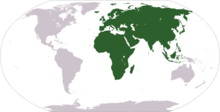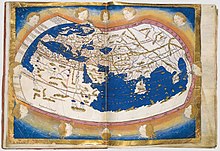
Back Ou Wêreld Afrikaans العالم القديم Arabic Vieyu Mundu AST Köhnə dünya Azerbaijani Daan na Kinaban BCL Стары Свет Byelorussian Стары Сьвет BE-X-OLD Стар свят Bulgarian প্রাচীন বিশ্ব Bengali/Bangla Bed Kozh Breton
This article needs additional citations for verification. (March 2013) |



The "Old World" (Latin: Mundus Vetus) is a term for Afro-Eurasia coined by Europeans after 1493, when they became aware of the existence of the Americas.[1] It is used to contrast the continents of Africa, Europe, and Asia in the Eastern Hemisphere, previously thought of by the Europeans as comprising the entire world, with the "New World", a term for the newly encountered lands of the Western Hemisphere, particularly the Americas.[2]
While located closer to Afro-Eurasia within the Eastern Hemisphere, Australia is considered neither an Old World nor a New World land, since it was only discovered by the Europeans later. Both Australia and Antarctica were associated instead with the Terra Australis that had been posited as a hypothetical southern continent.
- ^ "Old World". Merriam-Webster Dictionary. Archived from the original on 2 April 2019. Retrieved 3 December 2014.
- ^ "New world". Merriam-Webster Dictionary. Archived from the original on 2 April 2019. Retrieved 2 April 2013.